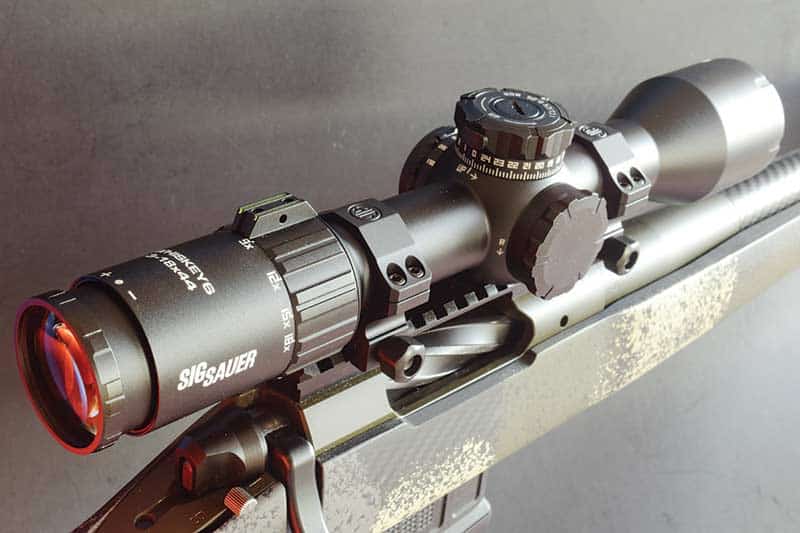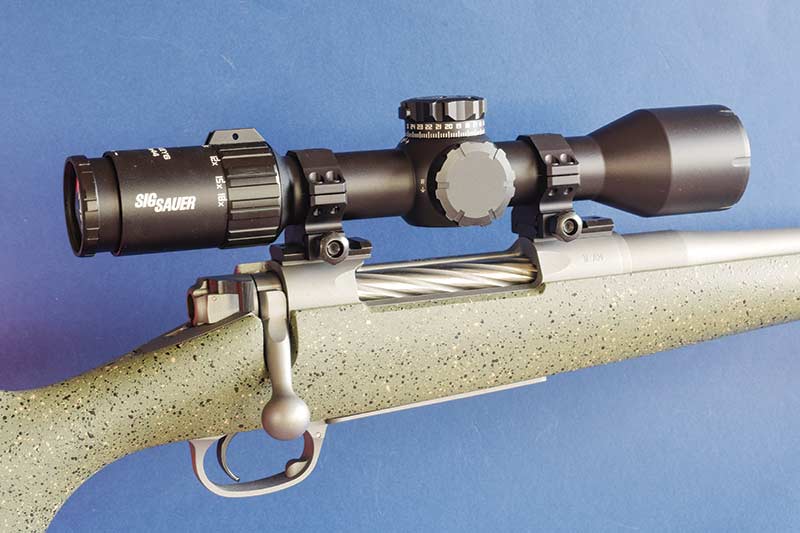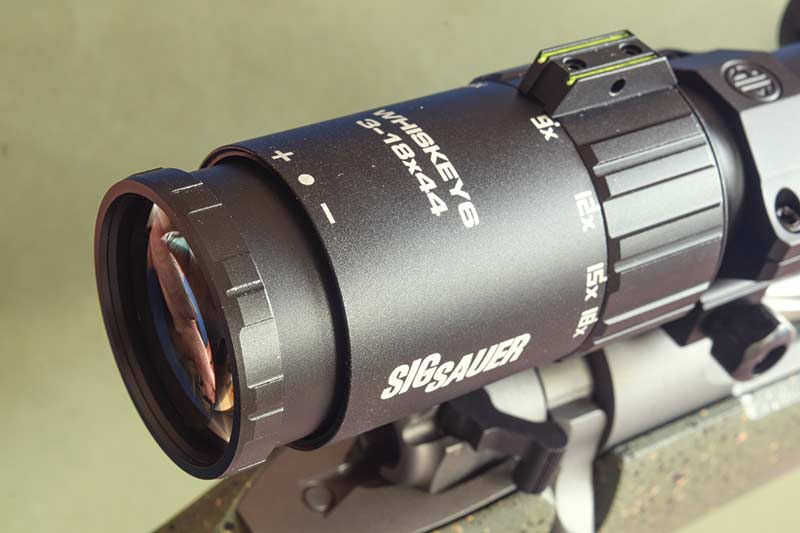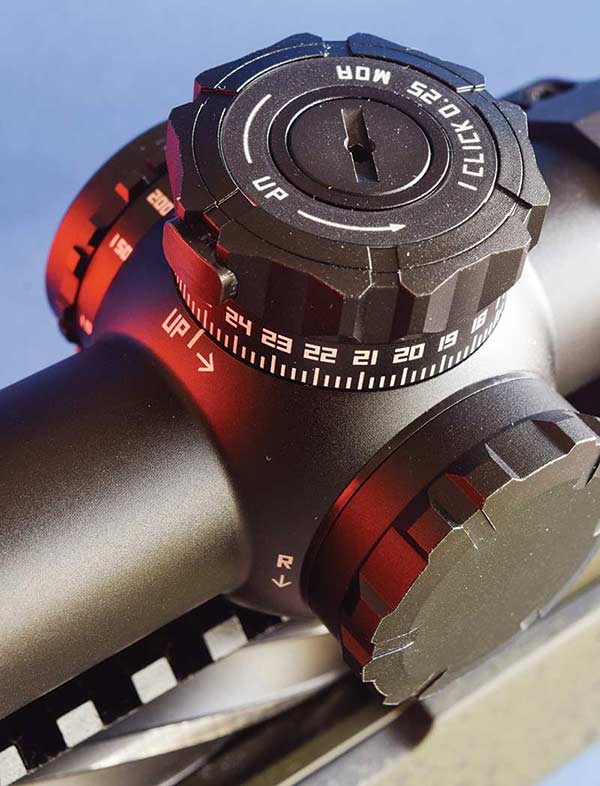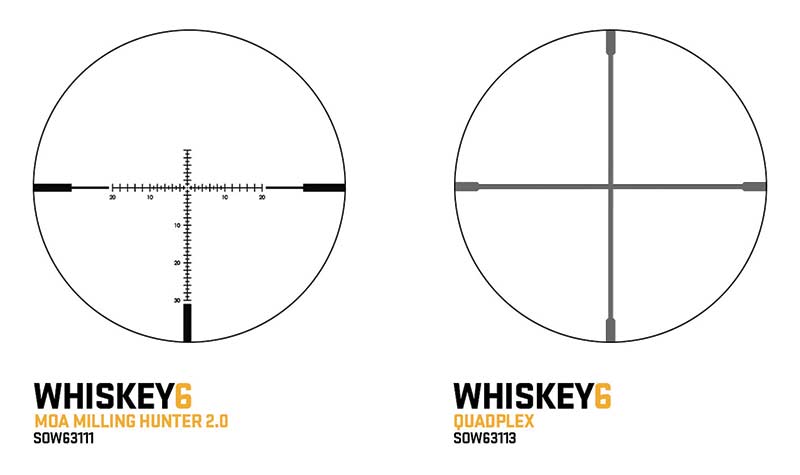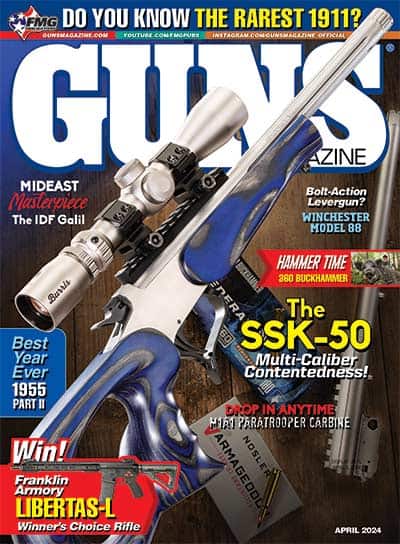SIG Whiskey6 3-18x44
All-Around Hunting Sight Redefines ‘Versatile’
As scope-makers all but relegate fixed 2-½x and 4x scopes to museums, I’m forced into weekly counseling to “manage my grief.” It is a humiliating and lonely experience.
“Keep a positive focus,” I was told — by someone who must consult Webster’s for the meaning of “reticle.” The market, she continued gently, reflects not just popular demand but the pace and direction of progress. “Acceptance is the first step in healing.”
SIG Whiskey6
So it came to pass I gave SIG’s newest rifle scope another look. It had, I conceded, a clean, taut profile — like the dimming memories of a lost love. Its 44mm objective glass was a refreshing dodge from the beer-can bells of its competition. The eyepiece, too, had a trim, efficient look. Despite a six-times magnification range, the Whiskey6 3-18x didn’t appear overly long or heavy.
The sample SIG sent confirmed first impressions. At just under 23 oz., it’s twice the weight of the scopes which pulled me from iron sights. On the other hand, it offers much more versatility and features than did its forebears — and sharper, brighter, flatter images. These days, hunters expect more help from their optics, to shoot farther with greater precision. They want a focus dial for crisp target images at any range and to eliminate parallax error. They assume predictable impact shifts with W/E adjustments made in the field and a reliable return to zero. Like top-shelf glass in 30mm tubes, features add weight.
There’s no illumination. While lighted reticles can bring faster aim in very dim light, I recall only once when such a reticle would have helped me. The elk was standing in dark timber just after sunset, and my 2 ½x Lyman Alaskan had a small dot on spider-web strands so fine they were almost invisible in good light. Given usual legal shooting times, a hunting reticle that brings your eye to target quickly in ordinary light will be adequate at dusk in the shadows. Certainly, illumination adds cost and complexity to a scope.
I like the way SIG engineered this scope. Overall length — 12 ¼” by my measure, with the eyepiece collapsed — is just half-an-inch greater than the Weaver K4 on Alice’s Winchester 75 .22 Sporter. The eyepiece is short too: under 3 ¼”. Almost centered between the steep angles to objective and ocular housings, the SIG’s compact turret leaves plenty of free tube for ring placement. A stock-crawler, I had no trouble attaching this scope far enough forward to clear my eye in recoil.
Nor would it trouble a shooter with shorter arms and neck. The 44mm front glass will allow use of low rings on many rifles. A scope hunkered low over bore-line encourages good cheek weld on stocks of standard dimensions and can be as fast on target as iron sights.
To find the ideal home for the Whiskey6, I tried it on three rifles: a lightweight Legendary Arms Works sporter in .280 Improved, a Springfield Armory 2020 Waypoint hunting/target rifle with carbon-fiber barrel in 6.5 cm and a mid-weight 700 Remington in .30-06, with a high-quality but hardly feathery synthetic stock. While it would have served on any of those, it best matched the 700 in weight and profile.
Range Trials
First: bore-sighting. Mounted in medium SIG rings on Weaver bases, the scope ran up against the zero stop before the reticle kissed the target. So I consulted the brief instructions SIG included. Removing the elevation dial with a coin, I nudged a small brass peg and re-installed the dial with additional clicks.
At this writing, winter has come to the Okanogan Valley, an hour’s drive from Canada. Snow has quilted my creek-bottom range. So a leisurely half-day burning powder under this glass will have to wait. But to see how well the scope repeated W/E adjustment and hewed to the claimed quarter-minute measure of each click, I did “shoot around the square.” That is, I fired a group, dialed 20 clicks right, shot another group with the same aiming point, came 20 down, fired again, came 20 left, fired, then finished with 20 up and a group at the original sight setting.
Horizontally and vertically, 20 clicks moved group centers 5.3″ — just a tad more than you’d expect from quarter-minute clicks. Each shift was on track, meaning there was no significant vertical bump to the horizontal travel, or vice versa. After 80 clicks around the square, I didn’t have to tweak the zero.
On hunts, I still think 250 yards is a long shot. With most bolt-rifle cartridges, this is about how far I stretch a 200-yard zero with a dead-on hold. These days, however, many hunters expect, and try, longer pokes. They may also use their hunting rifles in long-range matches, banging steel at four-figure yardage. Magnification as high as 18x — reserved for bulls-eye rifles in my youth — strikes these shooters as useful for shooting game too. Four-, five- and six-times power ranges put wider and brighter fields of view at their finger-tips. An exposed elevation dial with crisp clicks, bold numbers and an adjustable zero stop let them crank in a higher arc instead of holding over their mark. Parallax error is magnified by distance, so a turret-side dial to “zero it out” makes sense. The dial also brings the target into sharp focus — or can help you read wind and mirage at distances shy of the target.
Reasonably Priced
Obviously, top-end materials and tight tolerances make all products more expensive. Comparing images in the new SIG with those delivered by other scopes on my rifles, I concluded the Whiskey6 is a sound buy at its $1,040 list price. SIG’s current website has it discounted to $800 — a bargain, in my view!
Rifle-scope manufacture is a world-wide industry, and competitive. The notion that the Germans have a corner on fine optics was on its way out before WWII. Now materials, engineering and production processes are shared worldwide. Parts are routinely made far from where they come together — Whiskey6 scopes are assembled in the Philippines — and profitable designs are soon copied.
There are other sights with six-times magnification and features to fulfill long-range fantasies. But to my mind, none better marries such features with fine optics in a hunting scope hunkered low on a trim hunting rifle!
I’ll so report to my counselor next week.
